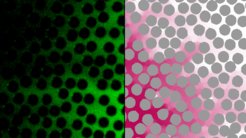It all depends on the neighbors
Researchers reveal transport dynamics in porous media
According to which laws do chemicals move through filters? Oil droplets through layers of rock? Or blood cells through a living organism? A research team led by the Max Planck Institute for Dynamics and Self-Organization (MPI-DS) and the Technical University of Munich (TUM) has discovered how the geometry of the pore space influences transport through liquids.
Thinking consumes energy. While you read these lines, the vessels in your brain dilate, the blood flow slows down, your 'reading neurons' are thus allocated more glucose and oxygen molecules from the bloodstream. "All of this happens without our doing. Over the course of evolution, nature has developed the ability to precisely adapt blood flow to the changing needs of organisms," explains Karen Alim, professor of biological network theory at TUM and Max Planck research group leader at MPI-DS. "Our goal is to understand the physics underlying this adaptive network."
The research team, which also included scientists from Nottingham Trent University, has now succeeded in taking a major step toward this goal: The new model describes for the first time how mass transport through complex porous media is controlled by their microscopic structures.
Porous media - in organisms as well as in engineered materials - are characterized by a complex system of cavities that can be penetrated by fluids that transport specific substances: In living organisms, trillions of cells are fed by small and tiny vessels; water or oil can circulate through the pores of sandstones; and bioreactors and filters contain porous catalyst materials that increase the reaction surface.
The secret of micro-flows

To analyze the flow-physics principle underlying these movements, Alim and her team took a new, experimental approach: the researchers chose microchips as a model for porous media, fitted them with tiny, columnar obstacles, and then passed a dye-containing liquid through the chips. Three different obstacle geometries were examined: In the first, the pillars were on a perfectly symmetrical basic grid; in the second, there were slight deviations from this symmetry; and in the third, the pillars were chaotically distributed. They measured how evenly the colored liquid spread throughout the pore space.
"The result was a real surprise," recalls first author Felix Meigel. The researchers had expected the liquid to penetrate the chip most efficiently with the symmetrical arrangement. In fact, dye transport was only moderate in that case: The dye spread along the direction of flow, but did not penetrate into the adjacent pore spaces. In contrast, the chip with the slightly irregularly arranged obstacles was the top performer. Here, the color-marked liquid meandered back and forth, quickly filling the entire pore space. The chip with the randomly arranged obstacles performed worst; areas formed there that were not reached by the dye at all, and the transport efficiency of the liquid was correspondingly poor.
It's the branching that counts
With the help of calculations, the scientists have now succeeded in explaining the phenomenon: "The key to our understanding was the network formed by the pores," says Alim. "Previous research focused on the individual pore, which meant that it was not possible to explain the complex overall system. We were able to show that it's the neighborhood that matters when it comes to pores." How a liquid spreads thus depends crucially on the branches of the pore space, the pore junction units. Like the branches in a pipe system, they control the direction and speed of flow.
"The results can now help to develop materials in which liquids spread optimally," predicts Alim. For example, the transport of ions in batteries can be optimized or the efficiency of catalysts or filters can be increased, which depends on how well the liquid reagents wash around the catalyst or absorber materials. And last but not least, the new findings could also help to better understand the dynamics of vein networks in living organisms. In her next project, the physicist plans to investigate how messenger substances control the optimization of blood transport.
This article was written in collaboration with the Technical University of Munich.
